
- Choose a blog category to explore -
Do I need a cover letter for my job application? My short answer is: no, unless specifically asked to provide one. The reason is that a cover letter is generally used for an unsolicited online application. Online applications are anonymous cold introductions without any personal touch. Best avoided.
If you have read my blogs you will understand my dislike of unsolicited online applications. Resumes from such applications accumulate in corporate inboxes. They are typically viewed in the batches, often by administrative staff – not the best way to make a solid first impression.
Applying online is not the optimal route. Following this route can strongly suggest that you are unable or unwilling to network your way a personal introduction with a future employer. Why not find a contact to introduce you to the right people? Sitting at home churning through online job applications is a lonely existence and ought to be avoided. With online applications you typically don’t receive confirmation that your resume has been reviewed, nor do you receive feedback on the status of your application or any suggestions on how to improve. You either get called for an interview or you don’t. It’s just black or white. Many large organizations insist on online applications with cover letters, but that doesn’t mean you can’t coordinate this front door approach with another more direct way to ensure your resume finds the right person.
Applying online should be your last resort. But what are the alternatives?
Warm introduction
The role of a recruitment agency is often to bridge the connection between you and a company you would like to work for. A good recruiter negates the need for online applications and cover letters. The recruiter’s expertise is to establish a fit between your skills and experience and a potential role. The most favorable approach would be to have a recruiter provide your profile and resume to the hiring manager. Now you can optimize your job application, ensure your resume finds the decision maker, and gain feedback from the process.
Networking
If the company is not working with agencies, then you can do some research, find out who the hiring manager is, and network your way to him or her. Be creative. Find someone who can help you make a connection with the company. Instead of attaching a cover letter to your job application, you could provide a brief email note to this contact person with the following five components:
- How you got the person’s contact information.
- A brief summary (3-4 sentences maximum) of your skills, experience, and immigration status (if applicable).
- What interests you about the company. Show the employer why you are interested by referring to projects, services, personnel, news stories, company values, etc, that have caught your attention.
- Why you would be a good fit for the role (if a relevant job posting is available). Highlight your understanding of the job requirements and outline your suitability for the role.
- Close by explaining what action you want the reader to take. For example, you could ask him or her to meet with you for a coffee, take a telephone call, or pass on your resume to HR or the Hiring Manager, as the case may be.
For more advice, read my quick guide to networking in Canada.
If you must write a cover letter. . .
The typical cover letter is focused on the candidate’s work experience and skill set. This information is already mentioned in his or her resume. Don’t repeat yourself. Cover letters can be effective when written well. This means your cover letter focuses on why you are a fit for a specific role or company and how you can add value to the company. A cover letter is the linking document between your skills and experience and the company.
Outpost Recruitment connects talented construction professionals with leading construction employers for civil, infrastructure and ICI buildings projects in Canada. To set up a confidential discussion, call us at 778-861-1244.
Outpost Recruitment founder, Ruairi Spillane, has spent five years placing jobseekers with Canada’s top construction and engineering companies in permanent roles. Jobseekers often ask themselves ‘should I use a recruiter?’ In this opinion piece, Ruairi outlines six scenarios where jobseekers should instead apply to companies in those industries directly. As one of the premier construction recruitment agencies in Vancouver, we think their advice can help you.
As a jobseeker, the idea of outsourcing your job search sounds fantastic. The job search often starts with a buzz of excitement and suddenly week or two later, it’s a very different story. Finding employment in Canada is an extremely slow process. Engaging with the right recruiter can help set your expectations, provide you with a trusted advisor and establish a clear strategy. That said, outsourcing your search to a recruiter is not always the best choice.
What are my options?
- Go it alone – use online jobs boards and personal connections to manage your own job search
- Engage the right recruiter – seek involvement of a recruitment professional to expand your knowledge of the market and include a wider network of opportunities.
To understand reasons why you should not use a recruiter, it’s important to first examine the reasons why companies will call on a recruitment agency to assist with their hiring.
- Urgent need – Outsource HR process due to time constraints
- Hard to find skills – Broaden the reach of HR
- Convenience – Client is happy to outsource their HR function purely to save time and effort
- Headhunting – Client use an agency to assist with an approach to a target
When a company pays an agency fee to source talent, they’re paying with the expectation that candidates presented by an agency are going to be of an extremely high quality. For the recruitment agency, this means the candidate must meet and exceed established job requirements
At Outpost Recruitment, we specialize in permanent roles for construction professionals across civil, infrastructure, and buildings projects. Based on five years of experience, we can gauge when a candidate’s chances will be hindered, because the employer is unlikely to want to pay a recruitment agency fee for a jobseeker who has to overcome a significant barrier. If they’re taking the risk of hiring that jobseeker, they want to do it as cheaply as possible, and it’s not in our interest or the jobseeker’s interest to present them to the company.
Here are six scenarios where we will usually advise a jobseeker to approach the company directly.
1. Lack of consistent work experience
When employers use a recruiter, they want a return on investment. Hiring a candidate who has never lasted beyond 2-3 years with a previous employer means this return on investment is less likely to be realized. Sometimes this movement is beyond the candidate’s control but if a candidate has displayed a tendency to “jump around”, then they are not an ideal recruitment candidate for an agency and will be better served directly convincing an employer of their merit.
2. Lack of relevant experience
If your experience level if way off the requirements for years of proven experience, then an employer is not likely to hire you via a recruiter. If you are junior or you are switching role/industry, we often recommend you apply directly. It’s rare that companies will use a recruiter for junior level roles so directly managing your job search is highly recommend for candidates with less than two years of proven experience.
3. Language barrier
Strong communication skills, including working fluency in the local language, are crucial when a company decides to use a recruiter. At Outpost Recruitment, we focus on technical roles so a candidate must have demonstrated their ability to work through English (Note: We are not active in Quebec so we focus on English speaking candidates only). If your written and spoken English is anything less than perfect, then you should consider managing your own job search. A recruitment fee is just another obstacle for you to overcome if you are not the perfect fit in terms of communication skills.
4. Lack of local / western world experience
The local experience paradox. Canada’s aging population desperately needs international workers, but employers crave local experience. If they don’t get local experience, they seek the next best thing which is experience in a similar western economy to Canada. Candidates without this level of experience will typically represent a higher risk to the client.
5. Cultural barrier
We often meet strong international candidates that cannot make a breakthrough because local employers are looking for a long-term candidate that will be a cultural fit in Canada. This is more common outside of the main cities but it is a factor to recognize. Candidates coming from differing cultures will always have a relatively higher settlement risk so we will often suggest that they job hunt directly to improve their chances.
For example, an international candidate coming from Sub-Saharan Africa to Edmonton may have a difficult time convincing an employer they are making the right long-term hire as the employer may be concerned that the candidate may struggle to settle in a dramatically different climate.
6. Immigration barrier
Unlike the Middle East and Australia, gaining employers sponsorship in Canada is extremely difficult and therefore not very common. Canada is a resource-driven economy so when commodity prices are low the demand for international workers in the economy will drop. If you need immigration assistance, it will dramatically reduce your attractiveness to a Canadian employer, so this presents yet another obstacle to finding employment. For these reasons, we rarely present candidates that require immigration assistance unless they are all-stars with extensive estimating or senior management experience.
Benefits of using a construction recruitment agency in Vancouver
On top of the points outlined above, you might still be unsure of the inherent benefits that come from using a dedicated construction recruitment agency like Outpost Recruitment in Vancouver. Honestly, we understand why you may have some reservations but benefits do exist. If you feel like the above six points don’t apply to you and you want to give yourself the best chance of finding a job that you’ll thrive in in Vancouver then we can help.
There are many benefits to using a construction recruitment agency like Outpost recruitment, some of the primary benefits are as follows:
Construction recruitment agencies have industry insights
While you may think that you know your industry inside-out, the reality is that this is unlikely to be the case, especially if you are making a start in a new city like Vancouver. As construction specialists, Outpost recruitment can offer a range of unique insights to both your sector and the city to ensure that you find the opportunity that best meets your needs. These type of insights can save you time, and increase exposure to other opportunities, as well as salary advice.
Construction recruitment agencies offer exposure for candidates
As well as have a range of experienced and in-depth insights, construction recruitment agencies can provide their candidates with the necessary professional exposure that can ultimately lead to a career rather than just a job. At Outpost Recruitment, we use our decade plus of combined experience in the Vancouver construction industry to give our candidates a little more exposure than they may receive elsewhere. Additionally, in some circumstances, construction recruitment agencies have opportunities which are not always available elsewhere, not to mention that working in partnership can give you a competitive advantage.
Construction recruitment agencies save you time and make you money
If you have ever spent time applying for a job then you will know that it is a full-time position in itself. So, if you want to save yourself time and effort while you search for your dream job in Vancouver then you need to enroll the help of a construction recruitment agency like Outpost Recruitment. On top of that, by working with us we can help you negotiate a starting salary that matches your skill and qualifications.
Need help figuring it out?
If you’re unsure as to whether these apply to you, or would simply like a second opinion, we encourage you to contact us so we can advise you.
We gladly represent jobseekers where it’s possible to do so. And if not, at least you’ll know.
There are many simple mistakes job seekers make, which can be easily avoided. Outpost Recruitment founder, Ruairi Spillane, explains how.
Over five years of working in recruitment, Outpost has gathered lots of anecdotal evidence on what works and what doesn’t when searching for a job. Do you have to use a recruiter? Absolutely not! But while most candidates may be excellent in their specific area of construction, many lack expertise in defining their strengths, managing their job search and their ability to communicate to employers.
1. A weak resume
If you cannot demonstrate your value on paper, then how can you communicate it to an employer in person? I wish I could stress this point enough as failing to put your best foot forward will delay your career progression. Outpost’s core competence in terms of consulting is to help a candidate discover their strengths and communicate them on paper.
2. Applying online
Applying online is a waste of time, there is always a better way! If you are a job hunter, you need to realize that you can network your way to find a useful contact with almost any company you wish. Use a recommended recruiter or LinkedIn to get to the decision maker instead of your resume being one of 200 on a pile. Seek to differentiate yourself!
See online job postings as the tip of the iceberg. Not all open opportunities get posted. You are missing a trick if you relying on the front door along with the crowds. Companies post roles when they can’t find good people via internal means. Being first is everything in your job search so network a better way.
3. Spray and pray
Be selective in where you send your resume. Document each application on a spreadsheet and control where you resume goes i.e. ask your recruiter to seek permission before presenting your resume. Canadian markets are pretty small, so employers talk. Focus on quality not quantity when making job applications. Believing that job hunting is a numbers game creates the wrong set of behaviours as you dismiss negative results or lack of results.
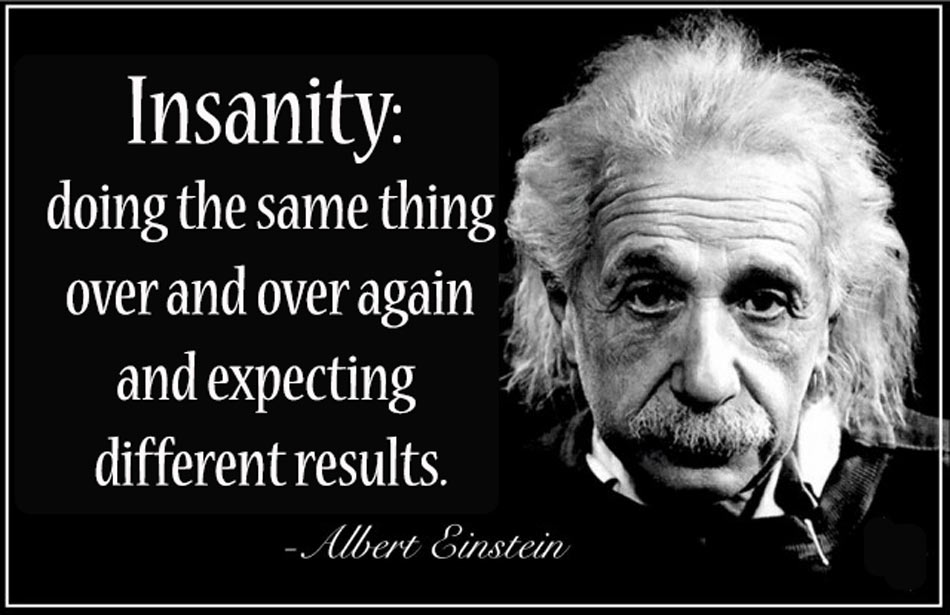
4. Misguided expectations
Nobody knows it all. It never hurts to chat to an industry peer to ensure your expectations are in check. Communicate your plans and ask a colleague, industry contact or a recruiter for their candid advice. Ensure you audit your job search tools (resume, LinkedIn profile, etc.) and your role and salary expectations before you start.
5. General job applications
While being a potential jack-of-all-trades is attractive when you are a junior / graduate keen to make a breakthrough, being undecided on your best role or potentially desperate is not. General job applications are a giveaway sign that you have not performed your research or you are not confident in your skillset. Be specific about what you feel you best role is and target this. Leave it to an employer to ask if you are flexible.
6. One resume fits all – Wrong!
Failing to adapt your resume to different regions, different industries and job titles is one of the most critical mistakes job seekers make. Do you want to look like a lazy job hunter or do you want your future employer to feel that you have taken the time to understand the region, industry and job title that you are targeting? Always adapt your resume every time you send it, so it meets the expectations of the specific job posting you’re applying to.
7. Punching too far above your weight
By all means, be daring and ambitious but also be realistic in terms of applying for jobs you are not qualified to do. Be aware of the difference between being ambitious and grossly under qualified for a role. Applying for roles beyond your skill set and experience will not help morale and the trade off is to spend more time applying for roles that you are qualified for.
8. Not following up!
“I sent him / her an email and he never responded” – Classic job hunters excuse when given a lead for help. Someone has created an obstacle in my path! Understand that your job search is your priority. Take responsibility for the outcome. Ensure you have a way to follow up and get it done. Seek to get a Yes/No from each employer instead of embracing the unknown.
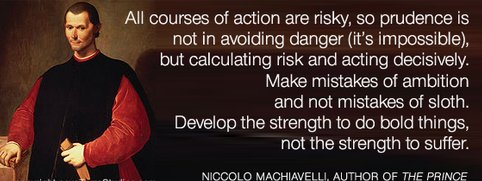
9. Ignoring help/advice
Take all advice on board and seek to understand where it is coming from. Your attitude to critical feedback has a huge determination on the success of your job search and your overall career. Seek feedback and ways to improve your process.
10. Immigration bubble
If a job is posted within Canada and does not welcome international applicants , then it’s fair to assume your chances of success as an applicant without a valid work permit are limited. Ensure you focus your time and energy of researching how to gain a work permit first instead of looking for the needle in the haystack role that can sponsor you. Become your own immigration expert and then you will impress a future employer.
Find out more
You now know how to avoid the most common mistakes job seekers make. Continue reading our series of blogs, to help you prepare for your career in Canada. Explore our articles now.
If you’re looking to advance your career, then you’ll need to make sure you take full advantage of the opportunities for networking in Canada. Outpost Recruitment founder, Ruairi Spillane, explains.
Why do some construction professionals follow a seamless upward path from role to role? How do recruitment agencies know exactly what companies are hiring at the right time? Networking!
Recruiters are professional networkers. Our business is having the right connections and access to all the latest news. Some of the below tips may appear obvious but we are amazed at how people can overlook the simple things.
Here are Outpost Recruitment’s 12 tips to successful networking in Canada.
1. Business cards

Handing out business cards is a self-branding exercise and makes you look professional. If you won’t promote yourself, then nobody will. You can order 100 business cards for around $20 online. It’s a small price to pay for the sake of your career advancement.
2. Do your research

Always do your research before you contact someone and ask for their time/help. Use LinkedIn, Google, their company website and any other resources available to help demonstrate you are motivated to build a relationship.
3. Know the best recruiters
It’s easy! Instead of trying to gather all the appropriate information on a particular market, speak with an industry expert to gather ideas and news. You don’t need to be job hunting to contact a recruiter for help. Keep communication channels open at all times.
4. Know the best people in your industry
Make a point of spending more time with colleagues whose networking skills you admire. Tag along with them to events or simply bring them for lunch and ask them for tips on how to keep up with the market.
5. Informational Interviews

Start at the top and work your way down. You may be pleasantly surprised that someone will respond positively if they feel you have something to offer their company.
6. Better still, offer lunch instead of coffee!
“If you want something done, ask a busy person to do it”.
With a little tact and persistence, perhaps you can persuade the person you want to meet to give up a portion of their time with the offer of some food instead of offering a mundane coffee. Everyone’s gotta eat! A small investment to get a busy person’s time.
7. Events for networking in Canada

Are there industry leaders giving a speech at these events? Don’t be shy about approaching them directly for a quick chat. Be respectful of their time, be ready with your business card, and leave the chat having agreed a way to follow-up with them at a later date.
8. Use LinkedIn
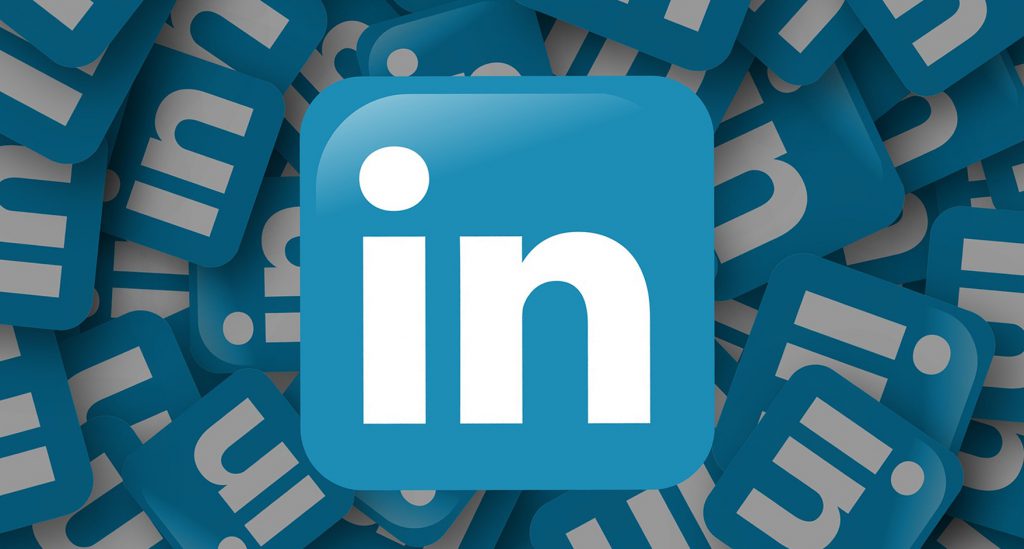
While connecting on LinkedIn is considered a reasonable follow up, try to take action on interesting contacts by following up and scheduling a time to chat further over the phone, a coffee/drink, or lunch. This one-on-one meeting is an ideal chance to further develop the relationship as being a LinkedIn connection is not very intimate any more!
Set a reminder to follow up with a connection in 2-3 days for essential queries or 2-3 weeks if it’s not urgent. Remember: your priority is to get to know them, so don’t be afraid to follow-up.’
9. Tact and Persistence
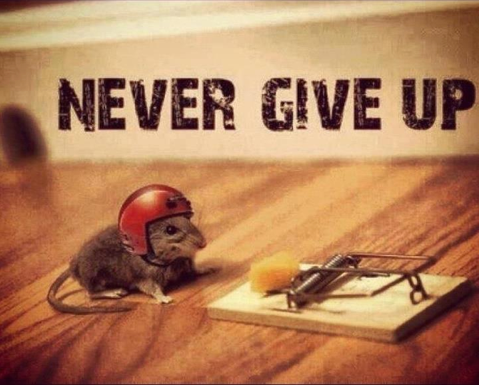
“I contacted Person X and they never got back to me.” This is such a lame excuse, so don’t use it. If you want their help, leave blame and ego behind.
10. Ask and you shall receive

11. Map out your connections

12. Dress to impress

For networking events, informational interviews and coffee meetings, business casual will suffice but ensure you wear a suit for an interview.
And remember…

We all know having a LinkedIn profile is a crucial resource in your job search. But the default LinkedIn profile URL can be long, clunky, and difficult to include on a resume or CV.
Luckily, LinkedIn provides an option for you to create a short, custom LinkedIn profile URL. By default, your URL will be something like: https://www.linkedin.com/in/alan-regan-245b5b42. But you can change it to something simple, like: www.linkedin.com/in/alanregan. It’s easy to do, and this guide will show you how.
Steps in creating a short LinkedIn profile URL.
1. Go to your profile.
Login to your account, and click ‘Profile’ from the menu at the top of the screen.
2. Update your public profile settings.
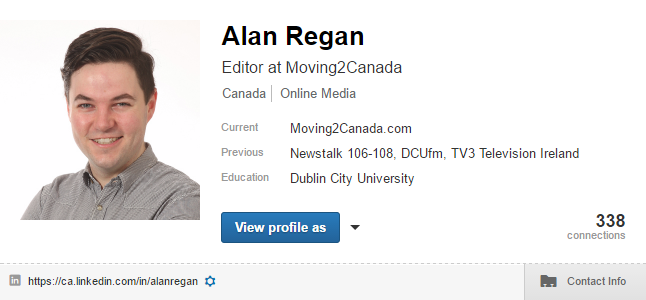
Move your cursor over the URL, which appears in the bottom-left of the image above. By default, this will be something clunky, like: https://www.linkedin.com/in/alan-regan-245b5b42.
When you do this, a little cog will appear beside it. Click on this, and a new page will open.
3. Edit your public LinkedIn profile URL.
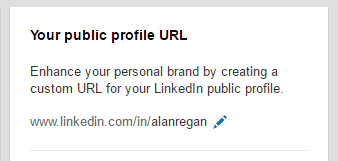
On the right-hand side of this new page, you’ll see a box which says ‘Your public profile URL’. Click on the pencil icon beside it.
Your new URL will begin with www.linkedin.com/in/. You get to choose what goes after this, but we recommend a combination of your first name and last name. For example, www.linkedin.com/in/alanregan.
And you’re done!
You can now use this URL on your resume, business cards, or any other document that’s likely to be viewed as a printed file.
We strongly recommend including your LinkedIn profile on your resume. A resume is simply a quick overview of your career history. Your LinkedIn profile gives you the chance to expand on your achievements, and gives employers to learn more about you if they so wish.
It’s important to have a short, custom URL on your resume. Yes, some employers will be viewing a digital file, and can simply click on the long, clunky link, or copy and paste it into their browser.
But many recruiters will be looking at a printed file. If you’re trying to impress them, make their life simple. Don’t give them a long series of random characters to try to type – give them an easy, custom LinkedIn profile URL instead. It shows that you’re keen to impress, and have taken the time to work on your recruitment tools.
It’s not enough to simply exist on social media – you need to know how to use LinkedIn if you want to get the most out of it. Outpost Recruitment founder, Ruairi Spillane, explains.
LinkedIn has become a crucial networking, information sharing and personal branding tool for construction and engineering professionals. Ignore it at your peril. Let’s focus on the numerous positives that can come from having an online professional profile.
Why is LinkedIn useful?
LinkedIn allows you to organize your professional connections, build an online presence and leverage common connections with other members of your network.
You can build connections that can assist you in meeting your professional objectives and engage with them. Whether you are searching for a job, keeping up to date on your field or looking to advance your career, learning how to use LinkedIn can help you achieve your goal.
Build rapport — If you’ve seen topical and relevant third-party articles, or have timely opinions on issues in your industry, you can post these on your profile or selected groups. This can help you engage with your existing network, and build new contacts. While it’s good to post often, remember that you should be aiming for quality over quantity.
Industry news — Your news feed will become an information resource for keeping in touch with latest events in your industry. Get involved in industry discussions and see what you can learn! Connect with our Outpost Recruitment group for latest industry news.
Warm introduction — LinkedIn allows you to establish degrees of separation when browsing for target individuals. Instead of a cold invitation to a stranger who does not know you, you may avail of the opportunity to ask a common (2nd degree) connection to introduce you. This is a very powerful networking tool.
Cold introduction — If you wish to be particularly proactive about exploring new opportunities, don’t be afraid to ‘reverse headhunt’. Learning how to use LinkedIn’s search tools means you can do this quickly and effectively. This essentially means identifying suitable companies or individuals to contact directly through the LinkedIn messaging feature. Providing a customized message explaining why you wish to connect is vital. Don’t just send a generic request, show them you have taken the time to study their profile.
Interview Preparation — Learn about the background of the hiring manager you are about to meet. This will help you understand the interview team and prepare some quality questions to ask. You may establish that you have common connections or else mutual interests with your future employers so don’t be shy on doing your research.
How to use LinkedIn to grow your network
Send connection requests to professional contacts once a relationship has been developed. Remind them of how you met if you sense they may not remember you. It’s always better to send a customized message when connected and ensure you follow up once your connection is accepted. Avoid connecting with strangers without sending a clear message on the purpose of connecting with them!
Join LinkedIn groups according to your industry, professional organization and regions to meet other professionals with common interests and keep you up to date on developments in your industry. Our Outpost Recruitment group posts the latest industry and jobs news, so be sure to connect with us to stay up to date.
Add a LinkedIn badge to your email signature. This will encourage people you are emailing to connect with you.
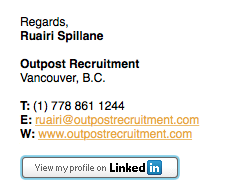
Success Tips
LinkedIn is a fantastic tool for promoting your career interests, so ensure you maintain a complete profile and communicate a positive, professional online image. First impressions last. Like most tools, keep in mind the expression “Garbage in, garbage out!”
A concise heading and title is important. These two parameters are crucial, and it’s important that you convey the appropriate message to viewers. For example, if you are job hunting, you can convey that by stating you are “seeking new opportunities in . . . ” on your profile.
Recommendations are handy, so ask colleagues, direct supervisors and happy clients to endorse your work as this greatly enhances your professional image, especially if you are job searching.
You can also use a LinkedIn request as a subtle way to nudge someone you have recently contacted. Instead of following up by email, send them a connection request and send your follow up email at a later date.
How to build a LinkedIn profile to impress
Professional photo — A high-resolution professional photo adds personality to your profile. A cropped image of you standing next to someone else at a dinner party, graduation photos or grainy historical images do not help your personal branding!
Clear objectives — Similar to your CV/resume, your profile should include a personal summary that is clear and concise. Who are you looking to network with? What types of roles interest you?
Relevant detail — Provide as much detail as possible about your results and achievements during your current and previous roles. Highlight a basic scope of each project you have worked on so anyone can visualize the tasks and your involvement.
Keyword loading — Optimizing your profile for searches is critical. Loading your profile with keywords associated with your desired role will return your profile in searches by recruiters. If you do not want your desire for a new role to be blatant, it is a good idea to embellish your profile with subtle keywords such as ‘seeking’, ‘opportunities’ and ‘new challenges’. Otherwise, being explicit with the fact that you are actively looking will attract the attention of hirers.
Increase your visibility — Joining relevant groups and being active in group discussions can increase your footprint within industries and can drive traffic to your profile. You’ll quickly discover this is how to use LinkedIn in a way that attracts interest in you.
Custom URL — By default your public link to your profile may contain a lengthy URL that looks like “tr.linkedin.com/pub/johnadams/70/887/b01/”. Ensure you shorten the URL if you would like to place this link on your resume or signature. See our How to create a short, custom LinkedIn profile URL guide for instructions.
Best of luck with your online networking. Don’t forget to connect with my LinkedIn profile and follow Outpost Recruitment.





